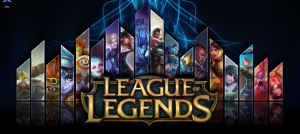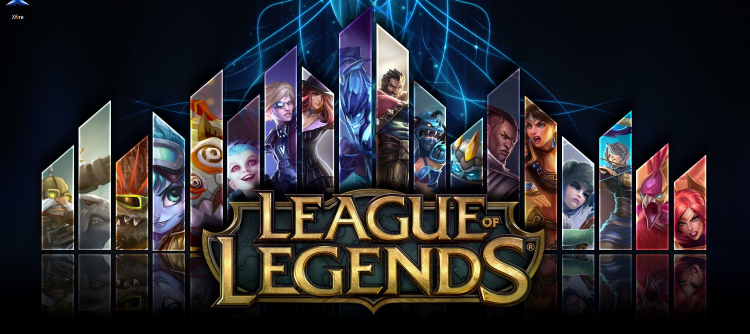Personal Narrative:
For as long as I can remember, video games have been an integral part of my life. Whether it was playing on the Playstation 1 with my father and brothers at a young age, having friends over to duel it out in fighting games and first person shooters, or simply gaming on my own as a way to relax, a good hobby of mine these past 18 years has been gaming. Of all the wide variety of games I’ve indulged in, League of Legends, a fantasy MOBA I’ve been playing since it’s launch in 2009, has probably held my attention the longest.

Above all, what has driven my knowledge of this game has been the fact that I have played it pretty consistently since it’s release, and unlike most people who play it, have seen it go through many changes and evolutions during its lifetime. Additionally, I will usually look up guides and watch videos on how to play certain characters within the game, and will sometimes scroll through the forums talking about strategy or changes within the game, all aspects that have helped me to gain a better knowledge of the game while I have played it. For example, every time a new playable character within the game comes out, I will usually go to Youtube and watch the official video published by Riot Games, the company who created and runs League of Legends, to outline the new characters abilities and techniques. While it doesn’t interest me that much now, I also used to watch and keep myself up to date on the international League of Legends competitions that happen every year. These competitions are huge parts of the League of Legends community, with both professional players and fans of the game obsessing over it as much as any sports fan might.
In regards to the characteristics of the League of Legends lexis, there is a lot of vocabulary that people who play League of Legends and other MOBAs know and use, as well as some basic rules that make up the game. In League of Legends, there are two teams made up of five people, and a map made up of three lanes with destructible towers, all connected and surrounded by a large forest filled with killable enemies inside. Each of these lanes leads back and connects to the two team’s bases, which house a destroyable building called the nexus inside. The object of the game is to make your way through these lanes into the other team’s base, and destroy their nexus before yours dies first. Additionally, groups of minions called “creeps” infinitely spawn and move down each lane, fighting the other team without direction or guidance from any of the players.
To play the game, each player chooses a unique character, referred to as a champion within the game, from a list. Each of these champions have a passive ability, as well as four other abilities the player can activate while playing. During the game, players will go down these three lanes and attempt to destroy towers, kill the opposing players, and kill the enemy team’s creeps as they come down the lane. All of these actions give the player gold and experience, with gold being used to upgrade players stats by buying items in the shop, and experience going towards levels, each of which gives players a point they can use to learn a new ability or improve upon an existing one.
Within these basic rules, there is a lot of strategy and technique that players routinely use to their advantage. For example, all of the playable champions are split up into different subcategories based upon their specialties and roles on the team. The categories include; tanks, marksmen, supports, fighters, mages, and assassins. In a typical game, a team’s strategy will usually consist of having one mage or assassin head down the middle lane, a tank or fighter go up the top lane, a fighter, tank, or assassin go into the jungle, and a support and marksman go down the bottom lane together. Besides this, techniques such as warding and last hitting are used extensively by players within the game. Although there is a lot of other vocabulary about the game I could explain, I will now direct my attention to some of the experts and personalities within the League of Legends community that are currently creating content.
Experts Assessment:
In the gaming community, the major ways of viewing content are through Youtube, a large video sharing website, and Twitch, a site that allows users to watch people stream videos live. League of Legends is no exception to this trend, with thousands of videos, most with impressive view counts, already in circulation. Just as how most commentators on ESPN and other sports networks are usually retired professional players themselves, many of the most popular Twitch streamers who play League of Legends are either retired or current professional players. Many people are drawn to this aspect of the stream, as it’s a way for them to get a glimpse into the strategy employed by some of the best players in the world. For example, one of the foremost experts currently within the League of Legends community is Lee “Faker” Sang-hyeok, a professional player who is regarded by many to be the best player in the history of the game. Not only has Faker achieved monumental success in the esports industry, being called “The Micheal Jordan of League of Legends” by Dustin Beck, the Vice President of Riot Games (Gamepedia), but he has also attracted enormous amounts of viewers on both Twitch and Youtube.
The above video, an unofficial compilation highlighting what some consider to be Faker’s best plays ever, has amassed over 1.3 million views on Youtube in just over a year. Similar videos showcasing Faker’s League of Legends skills, backstory, and life routinely attract millions of viewers as well, with many of them revering him as much as someone may love a mainstream athlete like Lebron James or Tom Brady. Within the world of Twitch, people have also flocked in droves towards the world’s best player ever. On his first day of joining the platform and streaming, Faker broke official Twitch records by amassing over 245,000 viewers, an incredible feat that could only be accomplished by someone as well known as Faker. For comparison, another expert within the League of Legends community Imaqtpie, a retired professional player who usually brings in some of the highest viewed streams for League of Legends, had only 38,000 viewers that same day.
This is nothing to scoff at though, as Imaqtpie is probably one of the other most well known experts in the community alongside Faker. His regular streaming on Twitch for the past three years now garners him over 2 million in profits a year (Weber), and this isn’t even counting his Youtube channel, with almost 1.4 million subscribers, or sponsorship money.
The Link to Imaqtpie’s Twitch Stream Can be Found here
Expert Evaluation:
Unfortunately, League of Legends has its problems. Within the player community, one of the defining characteristics is how “toxic” (a term in gaming that describes a player who continually harasses or disparages other players) many people can be while playing this incredibly popular MOBA. Although this happens within all online gaming communities (great examples being games like Call of Duty and Dota 2) the League of Legends community has always had a particular problem with their players spewing hateful rhetoric towards each other during games. I know that in my experience playing the game, I’ve regularly encountered toxic players in alarming numbers, and almost any League of Legends player you ask could give at least one example of a time they had to deal with a toxic player on either their team or the opposing one. The video below is an extreme example of a player being toxic towards their teammate, but nevertheless showcases just how much these types of players can ruin the game for everybody else.
Warning: This video contains extremely strong language and offensive verbal abuse
Of course, this is only one example, and obviously can’t enough provide evidence that a defining characteristic of the League of Legends community is its toxic players.
To look for more evidence, one has to go no further than Riot itself, a company that is currently investing lots of time, energy, and money into figuring out how to curb the proliferation of toxic behavior within League of Legends. An article by Jeremy Hsu from wired.com, titled Inside the Largest Virtual Psychology Lab in the World, Hsu explains how Riot is currently analyzing large quantities of data within their own game to research ways to improve toxic behavior. Obviously, toxicity must be a large problem within the League of Legends community, if even the games owners are now working on ways to stop people from harassing each other so frequently.
Another fact that supports my claim is that many people within the League of Legends community itself agree with me on the sometimes overwhelming amount of toxic players one tends to encounter. On the League of Legends boards, a forum that allows players to post discussions and respond to each other about different things concerning the game, simply typing in “toxic players” into the search bar brings up a host of discussion topics discussing peoples frustration with toxic players, or asking why there are so many in each game they play. 
The sheer number of these posts, and the fact that most of them make the same comments about League of Legends having one of the most toxic communities, serves to reinforce my claim about this defining characteristic of the community in this game.
Finally, an article by Brendan Maher published on nature.com, titled Can a Video Game Company Tame Toxic Behavior?, provides some interesting information that further supports my claim. In the article, Maher talks about some of the research on toxic players Riot is currently embarking on. What researchers found during their experiments was surprising, as it was found “…that only about 1% of players were consistently toxic” (Maher) and that “The vast majority was from the average person just having a bad day” (Maher). Since League of Legends is currently the most popular game on the planet right now, with over 100 million monthly players, this research shows that one of the reasons for the toxicity within the League of Legends community may just simply be because of how many players it attracts, and that as long as it retains such a high player base, it will always have more toxic players than other games due to its massive size.
Works Cited:
Websites:
Carpenter, Nicole. “Faker breaks Twitch streaming record.” Dot Esports, Dot Esports, 7 Sept. 2017, dotesports.com/culture/faker-breaks-twitch-concurrent-viewer-record-skt-lol-4680. Accessed 10 Sept. 2017.
Erzberger, Tyler. “The world’s top 10 players in League of Legends.” ESPN, ESPN Internet Ventures, 10 Aug. 2016, www.espn.com/esports/story/_/id/17268555/the-world-top-10-players-league-legends. Accessed 10 Sept. 2017.
Hsu, Jeremy. “Inside the Largest Virtual Psychology Lab in the World.” Wired, Conde Nast, 15 June 2017, www.wired.com/2015/01/inside-the-largest-virtual-psychology-lab-in-the-world/. Accessed 10 Sept. 2017.
Leaguepedia | League of Legends Wiki. “Faker.” Leaguepedia | League of Legends Wiki, Gamepedia, 26 Aug. 2017, lol.gamepedia.com/Faker. Accessed 10 Sept. 2017.
Maher, Brendan. “Can a video game company tame toxic behaviour?” Nature News, Nature Publishing Group, www.nature.com/news/can-a-video-game-company-tame-toxic-behaviour-1.19647?curator=MediaREDEF. Accessed 10 Sept. 2017.
Person. “Meet the Retired Pro-Gamer Who Earns $2 Million a Year.” Rolling Stone, Rolling Stone, 29 Mar. 2017, www.rollingstone.com/culture/news/retired-pro-gamer-michael-imaqtpie-santana-earns-2-million-a-year-w473992. Accessed 10 Sept. 2017.
Tassi, Paul. “Riot Games Reveals ‘League of Legends’ Has 100 Million Monthly Players.” Forbes, Forbes Magazine, 13 Sept. 2016, www.forbes.com/sites/insertcoin/2016/09/13/riot-games-reveals-league-of-legends-has-100-million-monthly-players/#3ff18e115aa8. Accessed 10 Sept. 2017.
Wynne, Jared. “The best League of Legends streamers on Twitch.” Dot Esports, Dot Esports, 7 Sept. 2017, dotesports.com/general/league-of-legends-twitch-streamers-2139. Accessed 10 Sept. 2017.

